RED TEAMING KOREAN REUNIFICATION: MULTIPLE-PERSPECTIVE UTILITY ANALYSIS FROM CHINESE ANGLE
Red teaming Korean reunification can aim to identify multiple scenarios leading to a strategic change. Adding utility analysis on top can help to choose the one future among many that can accrue highest utility to the tasking authority.
The technique of Multiple-Perspective Utility Analysis (MPUA) is as old as the pyramids. Probably older.
Alongside with being one of the oldest, it is also one of the simplest. May be that’s what explains its long run and persisting popularity. It is unpretentious. But at the same time it can add lots of value to the analysis of a strategic issue.
Later in this post we’ll explore how MPUA permits to offer a judgement regarding what trigger of the reunification scenario might have the highest Expected Value from the perspective of China. This power has big stakes in the Korean gambit. It might be illuminating to try and figure out what it might perceive as the most useful course of action.
But first, let’s go off at a tangent to our declared topic.
Let me digress to walk you through a step-by-step tour of the MPUA technique.
-
Step 1. Use divergent/convergent thinking to identify some seven possible strategic options.
-
Step 2. Use weighted pair ranking to identify three top-ranking (i.e. having the highest utility) options.
-
Step 3. Before we can start with MPUA, we need to choose our perspectives.
-
Step 4. Determine the perceived probability of success or failure of each of our three options.
-
Step 5. Ask each of “perspectives” to assign values to success AND failure of each options.
-
Step 6. Calculate the merged perspective.
-
Step 7. Seek input from DETAK.
Like any structured analytical technique, MPUA involves a fairly rigorous approach that won’t allow you to cut corners.
Right, so MPUA focuses on the utility analysis of problems that involve multiple perspectives.
As a matter of fact, most foreign policy problems involve more than one stakeholder. And as a rule, these multiple stakeholders will have conflicting interests. It can be fairly difficult to figure out their consensus view. But political decision must be based on – or at least informed by – some kind of consensus.
MPUA helps to identify that consensus.
Here is the kicker:
the approach to valuating and calibrating utility is highly individual and subjective. It means that utility analysis can be useful to assess the expected value of options whose utility will accrue to YOU.
It won’t be equally illuminating when you try and assess the value of options taking SOMEONE ELSE’S perspective. There is hardly a way you could ever credibly figure out how someone else values available options.
Because of that, role-playing will very likely – almost inevitably – result in succumbing to the mirror-imaging bias leading to a deceptive outcome. MPUA does not lend itself easily to the Red Team technique.
It doesn’t mean that MPUA should not or cannot be learned through red teaming. It mainly means that one should not make any big assumptions about results gained through simulations.
As a warm-up, consider the following scenario.
Our government is confronted with a tricky situation.
A foreign regime it has been supporting for decades faces an armed insurgency.
Which side should our government take?
Here are some of the arguments for sticking with the regime.
- Solid trade relations. Since decades the regime has been surviving largely on exports to us. The latter are also crucial to our own economic growth.
- Our side has made big investments in exploration, mining and transportation infrastructure.
- In return, the regime has been a steady importer of our military hardware and has granted us the use of a naval base.
- This ensures our side a political, economic and military foot-print in a key geo-political location.
However, it’s not all roses.
- Recently, early-warning indicators were triggered suggesting a possible partial defection of the regime to a competing military supplier.
- Intelligence reports graded at A2-3/B1-2 levels infer that the regime has sent out feelers to a competing power with an offer of switching strategic allegiances, for a price.
- The regime’s military tactics are dated and generally ineffective. Military high command thrives mostly on propaganda and chest-beating. Morale among ranks is low.
- Putting it in a nutshell, our friendly regime is corrupt and incompetent. It blindly believes in its own propaganda and has an abysmal human rights record.
Doing a scan on insurgents, they look quite a bit like a pig in the poke.
What little we know about their attitudes and ambitions can be summarised as follows.
- Highly disciplined and motivated, with internationally educated and intelligent leadership.
- Competent military strategists, engaging regime forces on own terms and at locations of their choice. Have established a foot-print in a land-locked and poorly populated area, from which conduct raids and sting operations against government forces and facilities. To engage the regime head-on, lack firepower and heavy military hardware.
- Have ample funding from undisclosed sources and appear to be honest about how they spend it.
- Are radical and militant but without an apparent religious undercurrent.
- Are openly pragmatic. Have reached out with clear messages both to our side and the competing powers, seem to be willing to go with the highest bidder.
- Have poor human rights record that at best matches the regime’s one.
Our role as analysts is to suggest to our decision-takers a forward-looking strategic option with the highest overall utility for our side.
Step 1. Use divergent/convergent thinking to identify some seven possible strategic options.
Seven is recognized as an optimal number – five are too few, nine are a tad too many. There is a number of widely-known techniques that can be used in this step. Our selection (after clustering and some weeding-out) was in the end reduced to the below.
-
- Stick with government.
- Switch to support insurgents.
- Let the two sides slug it out, supply firearms and heavy systems to both.
- Broker and host a cease-fire conference.
- Attempt to get UN peacekeepers involved.
- Join the hostilities at regime´s formal request. Use cruise missiles and air raids to destroy insurgent bases, supporters and in particular, leaders.
- Organise a coup against the regime putting in place an untainted government completely loyal to our side, taking the wind out of insurgent´s sails.
Step 2. Use weighted pair ranking to identify three top-ranking (i.e. having the highest utility) options.
Pair ranking is the simplest structured technique of them all. Still, it is surprisingly powerful.
Ranking is one of our instinctive mental activities that are continuously whirring in our subconscious. To rank means to assign a position to something relative to something else. Selecting or choosing something is the outcome of a ranking process.
Ranking can be intuitive (I like it, I like it not, I like something more/less than something else). There are at least two weaknesses in the instinctive (or intuitive) method of ranking.
- We tend to apply different criteria to different characteristics of the different items being ranked.
- We tend to regard all of our criteria as having equal importance to us. But this is never actually the case. What’s more, our likes and dislikes can easily shift during a single ranking process.
In pair ranking, on the other hand, we rank every option against every other one, in pairs. The option that has won most pair contests ranks at the top. Each option is separated and can be analysed independently, systematically and sufficiently.
Pair ranking provides an absolutely reliable indicator of each option’s ranking relative to others. Overall ranking is delivered by a process, and not by a decision, or a flash of inspiration.
With only a few options, the procedure will work just fine. With a longer list of options, your mind will likely rebel at the seeming tediousness of this method. This is only natural.
What’s happening here, is we are running against our mind’s grain. Against the natural way it prefers to operate. So, it naturally feels uncomfortable and protests. But once we make it accustomed to pair ranking it won’t want to work in any other way.
Now let’s delve a tad deeper in the workings of our mind by introducing the concept of criteria. A criterion reflects a core feature, aspect or characteristic of the type or category of options we are ranking. Using the process of divergent/convergent thinking explained in Step 1, we have identified the following seven criteria that apply to the problem we are analysing.
- Cost.
- Exposure.
- Short-term payoff.
- Chances of success.
- International backlash.
- Long-term benefits.
- Complexity to execute.
Then we use simple pair ranking to pick the three top-ranking criteria. Those are the ones that we consider to be the most important/useful option attributes.
Long-term benefits criterion ranked at the top with a score of five. They were followed by Cost and Complexity to execute criteria each with a score of four. That produces the criteria weighting of 0,38; 0,31; and 0,31 again, respectively.
Two criteria cannot have the same weight by definition. We adjust the weight for the Cost criterion to 0,32 and the weight of the Complexity to execute criterion to 0,30.
Why not the other way around? Because the criterion Cost has won their individual pair ranking contest.
Now, we can rank our seven options by each of the three criteria.
Each time we conduct pair ranking focusing on ONLY ONE attribute of our options.
Yes, it is mechanical. Yes, it may seem a bit laborious. But that’s precisely the reason why it is so reliable and valuable. It does not allow us to make shortcuts in our reasoning. And while the whole process may seem long each comparison is quick and natural.
Compare the outcomes of ranking by different criteria.
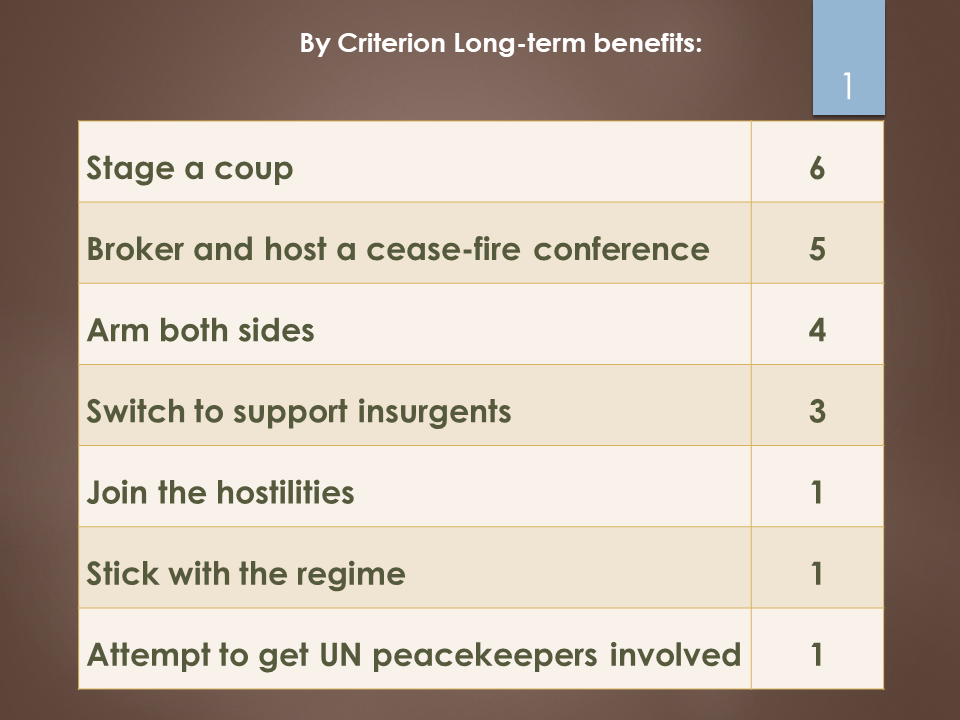
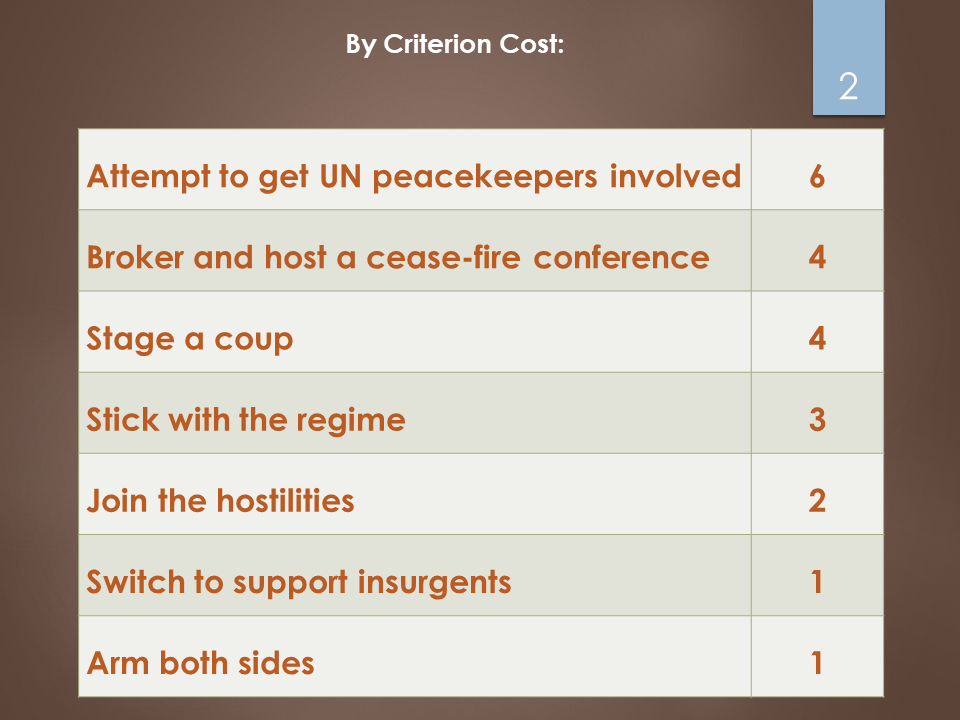
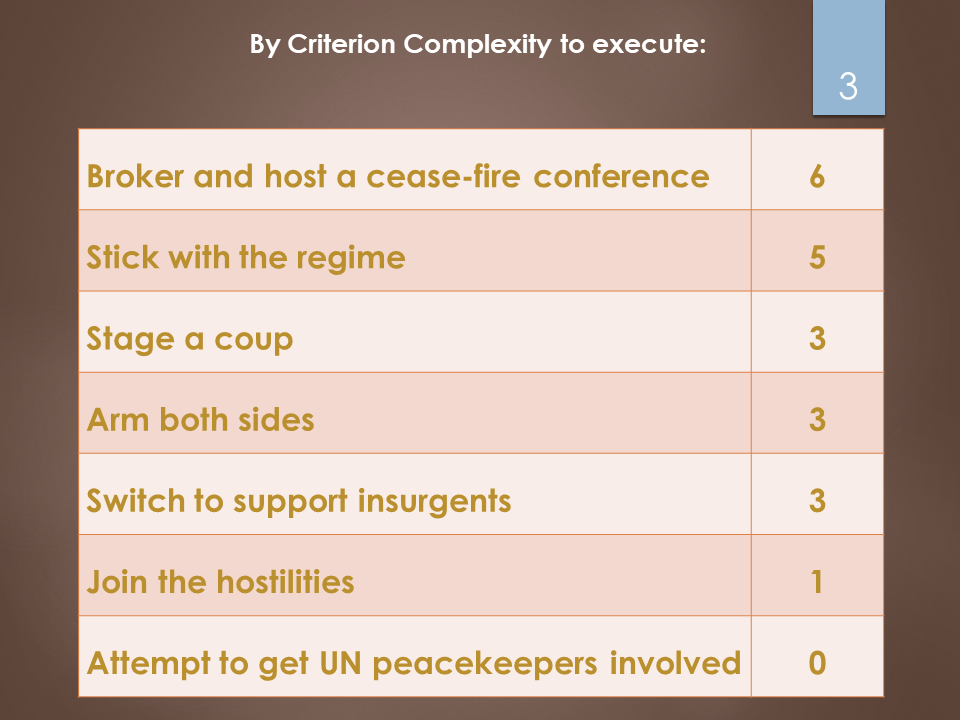
Options rank in very different order, which is precisely the point. It tells us that our set of criteria is sufficiently diverse.
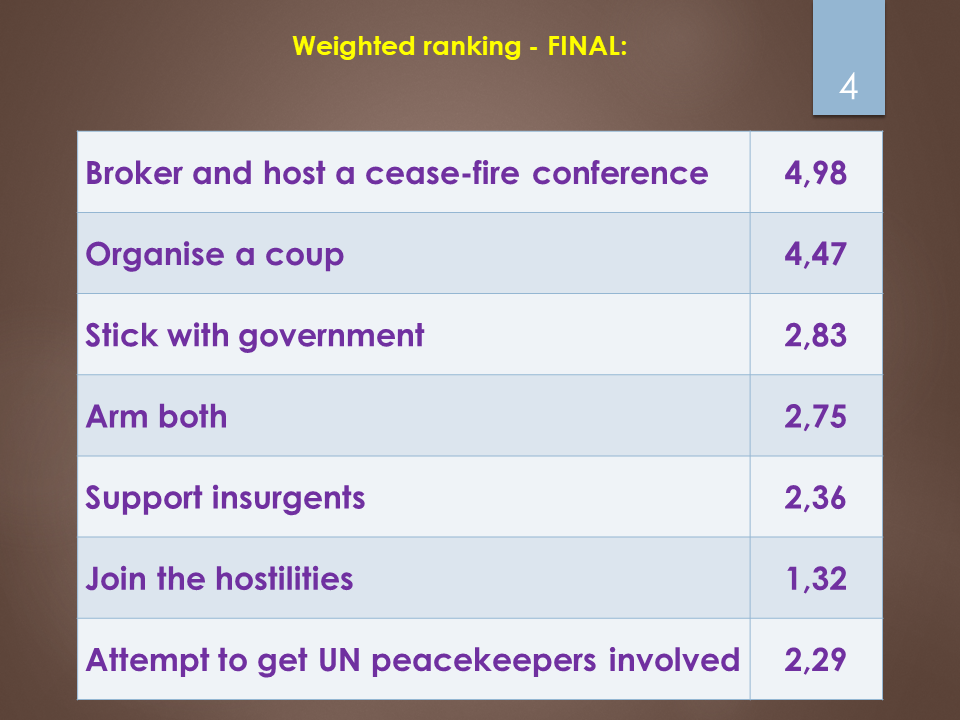
The top three options will be subjected to the actual MPUA technique. Don’t be surprised if the result of weighted ranking is unexpected, unusual or even discomforting. When our intuition is overruled by a conscious and structured thinking process, it is only natural that our subconscious feels uncomfortable with the outcome.
Step 3. Before we can start with MPUA, we need to choose our perspectives.
Perspectives are represented by stakeholders. Perspectives/stakeholders need to be precisely and narrowly defined to represent key individual or group stakeholder interests in the strategic problem we are analysing. There should be at least three perspectives. We’ll use five. More is better.
- Department of Defence.
- Department of Foreign Affairs.
- Foreign Intelligence Service.
- Department of Economy and Trade.
- Parliamentary Foreign and War Affairs Committee.
In real life, every attempt should be made to involve actual stakeholders in option valuation. Analysts taking part in a red teaming exercise will make a poor substitute.
Step 4. Determine the perceived probability of success or failure of each of our three options.
We complete this step is completed at the start of a MPUA run to record the consensus view of the stakeholders. The analyst will act as the moderator.
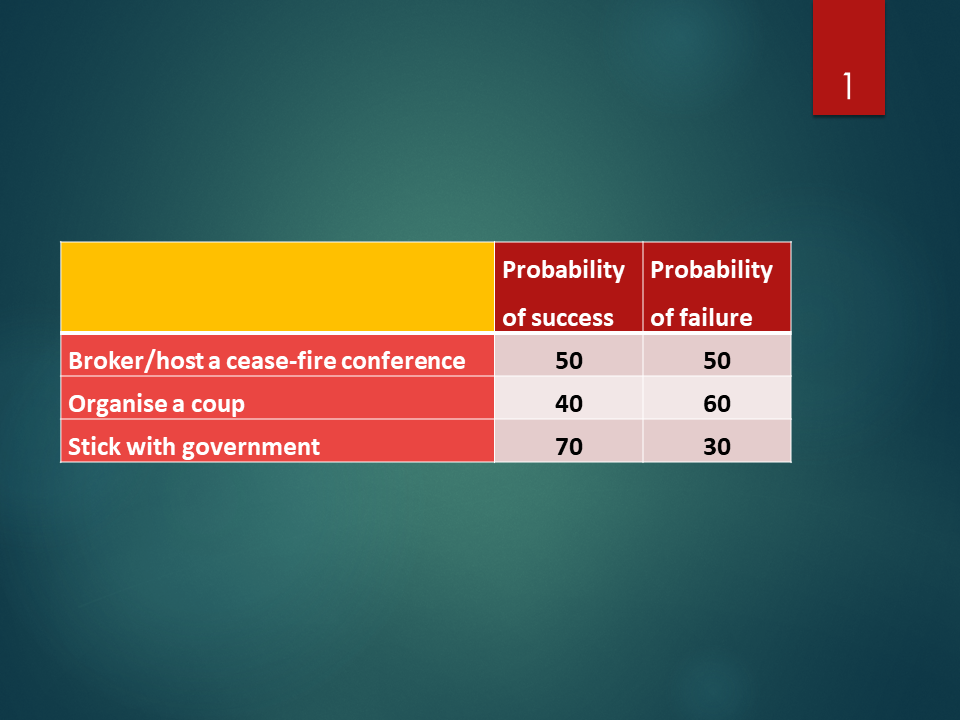
Step 5. Ask each of “perspectives” to assign values to success AND failure of each options.
Don’t be surprised: failure as an option outcome will almost always have at least some utility.
From the perspective of Department of Defence, diplomatic options have little utility. DoD role in their execution and accordingly the number of kudos they could get will be minimal. A coup would in all probability obtain a higher utility valuation, as the new government would inevitably seek broad DoD advice on military topics. Full utility would be given to continued cooperation with the present government, where DoD plays a lead role.
Options focused on diplomacy would naturally obtain higher utility valuations from the Department of Foreign Affairs. It can be further expected that DFA would be capable of harvesting significant utility also in the case of their failure. Diplomacy, after all, is the art of the impossible, right?
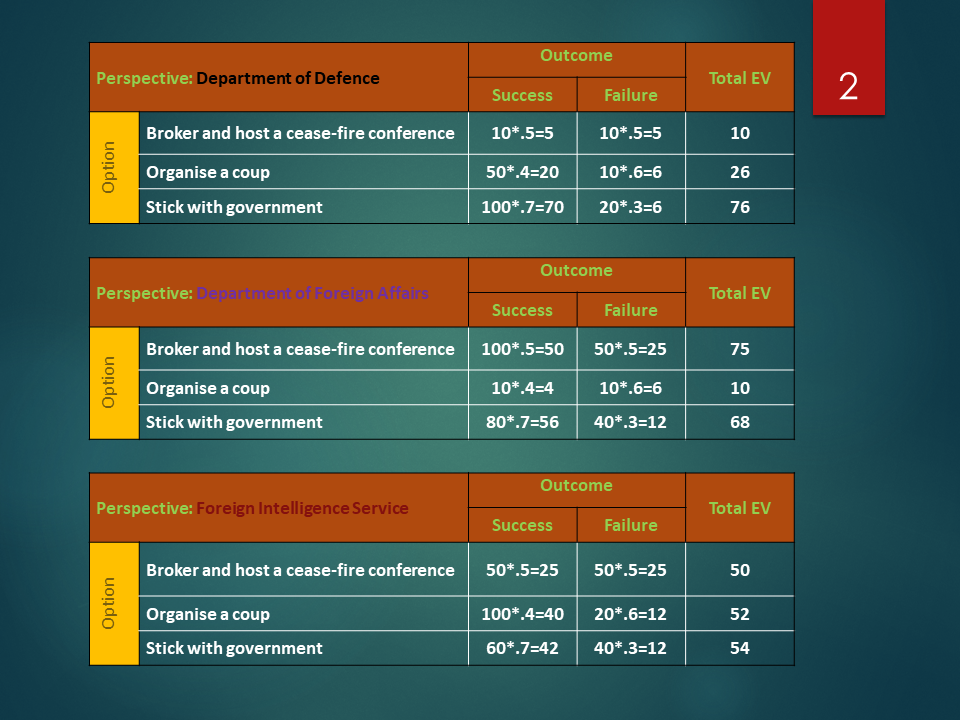
The Foreign Intelligence Service would extract at least some, and often plenty of utility, from every outcome of every option. To have a finger in every pie is the nature of their business.
The Department of Economy and Trade would focus on the objective of keeping a sensible trade balance by 1) ensuring a steady flow to our side of key regime exports and 2) facilitating and processing our arms sales, preferably to both warring sides. It could mean that DoET would be indifferent to the option of a cease-fire conference. Perhaps seeing some utility in its failure. It is likely to see a bit more utility in a coup, be it successful or not. And it would assign top utility to the continuing cooperation with the current regime.
And finally, the MPs. It would be tempting but flawed to discuss the parliamentary perspective as such. This approach will produce only vague and synthetic valuation. It will entwine too many different interests and motives. Instead, a Parliamentary committee wiil serve as a sufficiently representative proxy.
It would probably be quite favourably inclined towards a cease-fire conference, particularly its success. It might also see quite some utility in the uncluttering result of a successful coup. On the other hand, a Parliamentary committee would possibly see little utility in sticking with a corrupted and HR-negative government with the resulting international backlash.
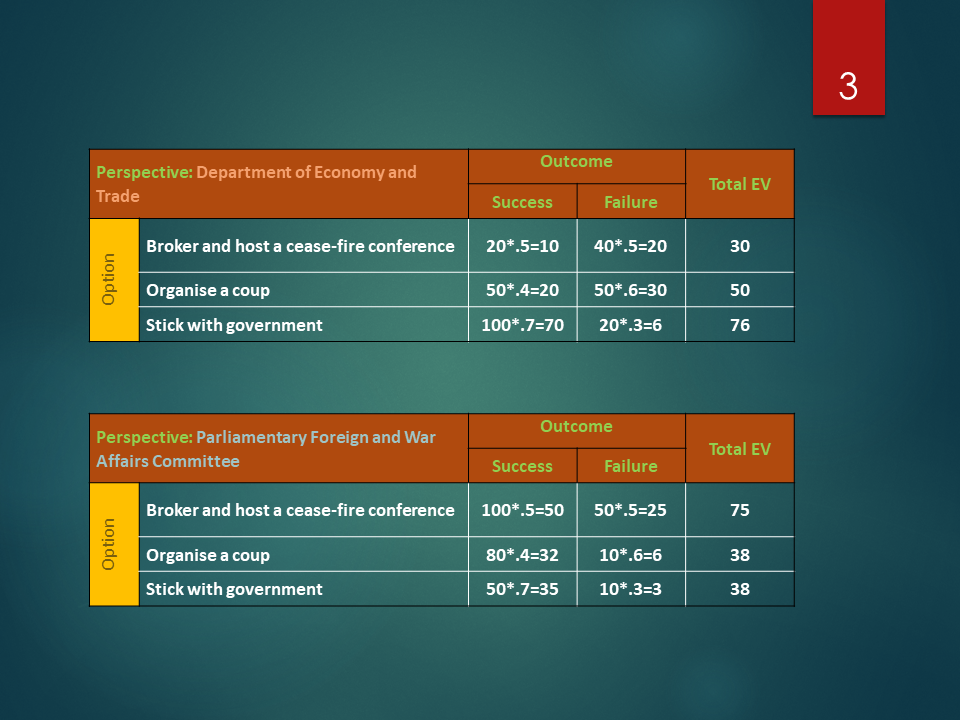
Step 6. Calculate the merged perspective.
The merged perspective shows the consensus of our five stakeholders regarding the option with the highest utility. One tactic that I can recommend is to first fill in the individual perspectives’ valuations by hand (using Word tables). Transfer the data to an Excel spreadsheet only when they are all done. Sure, it will take you a bit more time. But this way you’ll avoid being influenced by interim calculations.
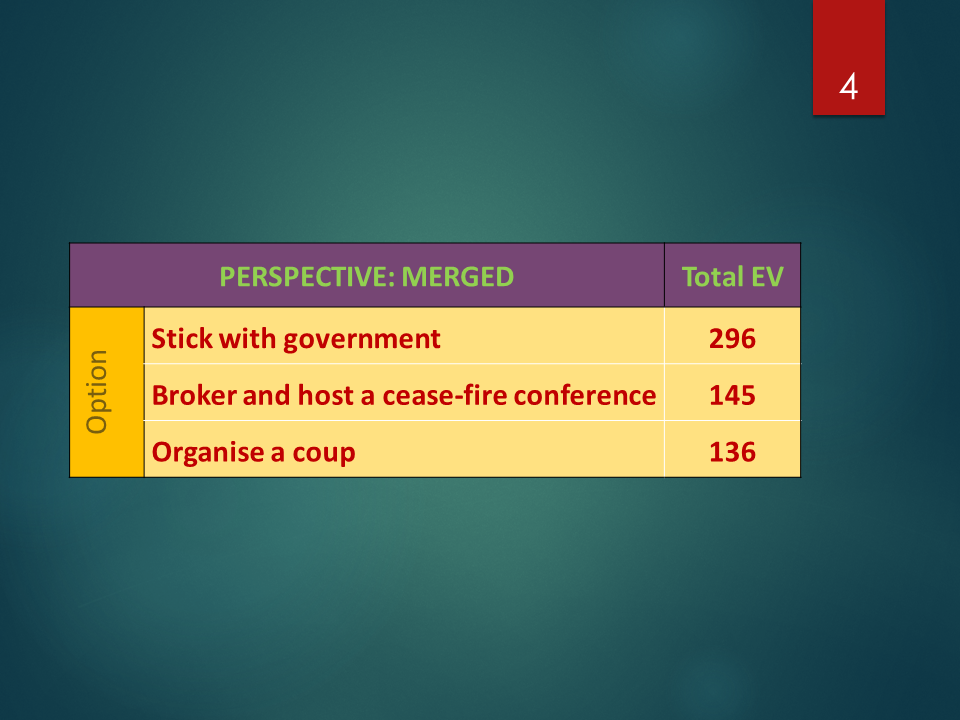
The most conservative option – which involves no change to the current strategy – wins with a convincing margin. The fence-sitting option ranks second in utility. And the option of strategic change trails in the back of the pack, though by a pretty narrow margin.
I consider this a fairly typical perception of utility in strategic planning. It is rather rare that stakeholders as a group end up in a consensus that favours radical policy change. It won’t be safe. And because of high risk, its perceived dangers would outweigh potential gain in utility.
In short, “Continue as usual” – or “Do nothing” – is a powerful option. One reason is, it can be a reflection of the Status quo bias that results in a subconscious preference for inaction.
The current baseline is taken as a reference point. Any change from that baseline is perceived as a loss. Confronted by an uncertain choice or by unfamiliar options, it is rather common for an individual’s mind to freeze. It becomes unable to choose among options.
In such a situation, a person will typically decide – emotionally, not rationally – that the best course of action is to take no action. To let things run their usual course. In retrospect, such a decision is then justified by all kinds of seemingly valid arguments.
Right, anyway, above caveats notwithstanding, we’ve arrived at the merged perspective. But that is not the end of the story, by far.
Step 7. Seek input from DETAK.
MPUA is rarely conducted on analysts’ own initiative. It is predicated on active involvement of high-level stakeholders. Analysts have no power nor authority over those.
The MPUA tasking will be thus done by the supreme decision-taker, be it an individual or a group. Let’s call it DETAK.
DETAK will naturally have a stake in the outcome and hence a voice in the process. And it must be a very special kind of a voice. DETAK won’t just offer another set of utility valuations like any of lower-level stakeholders. That would hardly ever significantly affect the merged perspective.
Instead, DETAK will have the authority to influence the merged perspective by weighting the three options under consideration.
Distribution of weights by DETAK among the options will mostly reflect its perception of utility vs. risk. DETAK may well favour the top-ranking option of the merged perspective. After all, it typically suggests the safest way forward. In such a case, the outcome of MPUA is sealed.
But what if DETAK allocates the top weight to a different option?
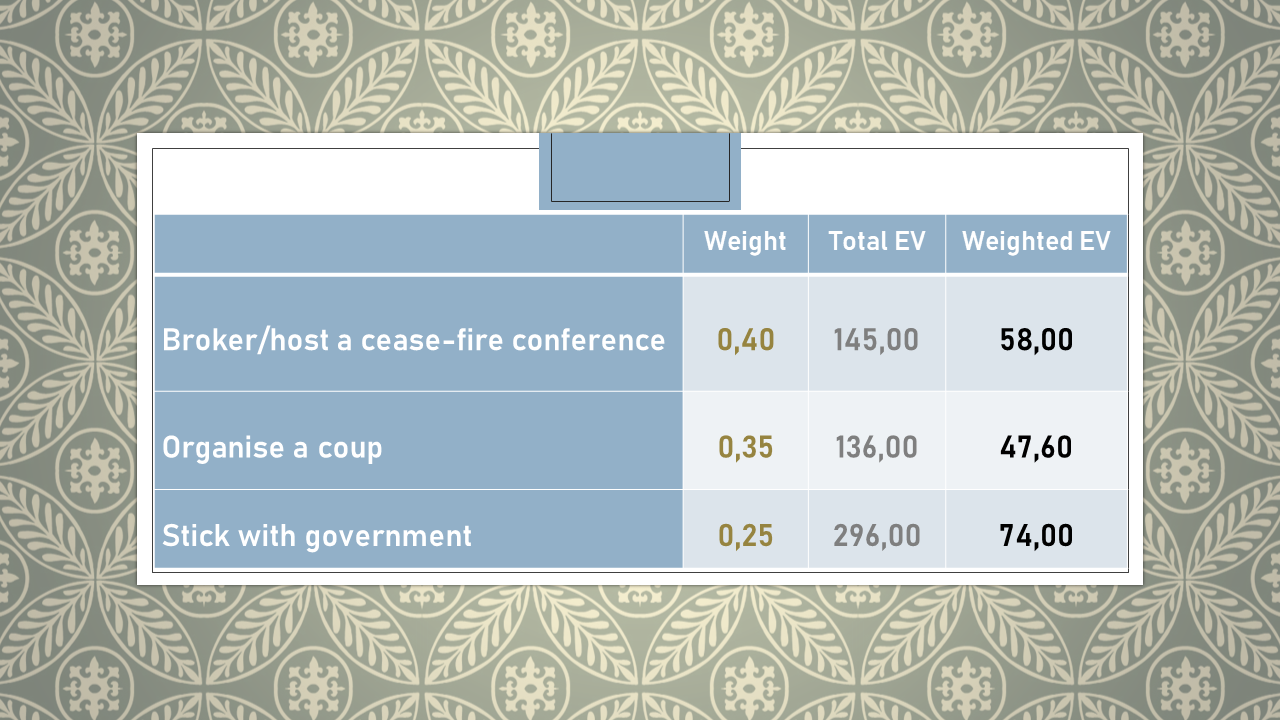
A fairly mild preference for an option trailing far behind the top one won’t necessarily push it up to the first rank. DETAK will takes note of that result and possibly include it in its considerations.
But if DETAK is willing to go out on a limb, so be it. Weight distribution at the limit of rationality will topple almost any merged perspective.
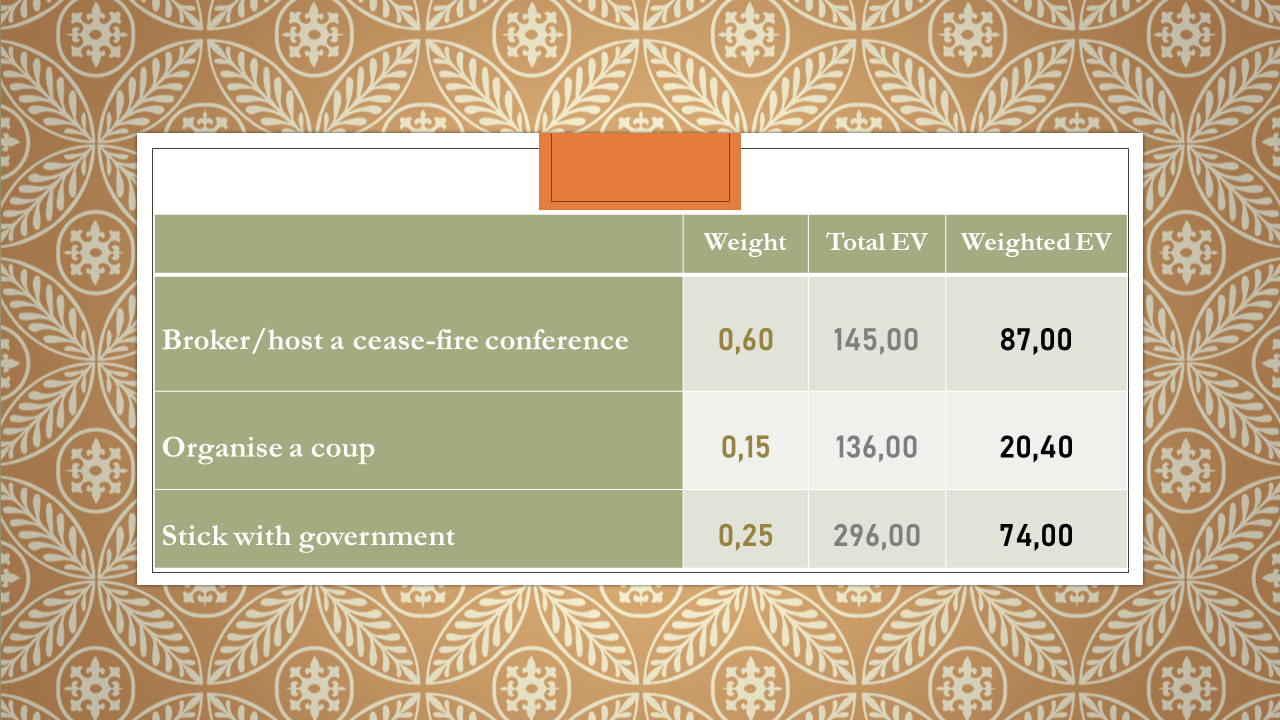
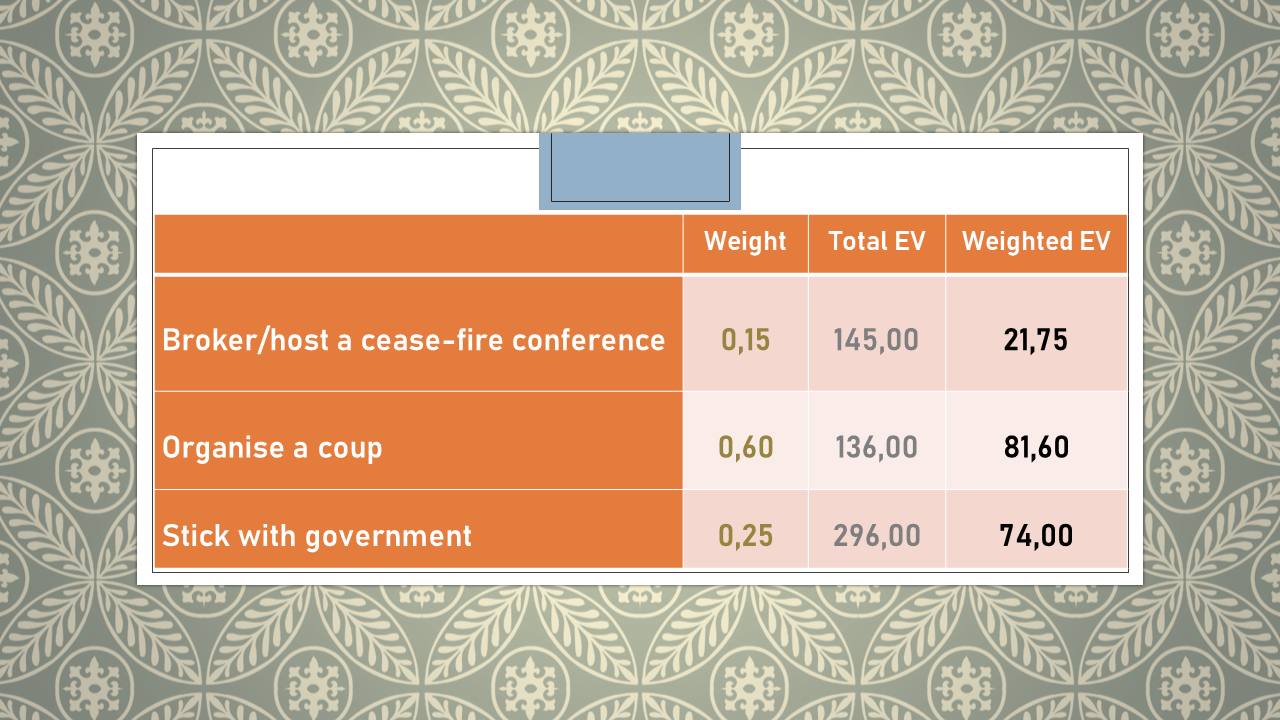
A summary of the added value of MPUA to DETAK.
-
It can provide an honest merged perspective = consensus.
-
It allows DETAK finding a way of overruling it.
-
But it won’t allow DETAK to shift the burden of responsibility for the fix.
Right, now we can turn to a real-life example of MPUA – well, kind of.
Below is a summary of MPUA exercise conducted in December 2019 by a group of my MA programme students. They chose to assess the comparative utility to China of possible strategic scenarios leading to the demise of the North Korean regime.
- Chloé Heller and Martim R. Ventosa enrolled in the Politics and Economics in Eurasia programme at MGIMO (Moscow State Institute of International Affairs of the Russian Ministry of Foreign Affairs). Chloé is also working as a journalist for the French newspaper «Le Courrier de Russie » based in Moscow. She can be reached at chloeheller@hotmail.fr. Martim can be reached at mv@godruid.com
- Students from Italy, Turkey and China including some on exchange programmes from French and Chinese universities who chose to remain anonymous.
Participation of the latter in particular made this project both an exceptionally thrilling and a useful one. There was red teaming involved all right. But it was conducted under the control of a home expert, ensuring that results were based on something firmer than pure mirror-imaging. It also helped that some of the group members had previously conducted research on DPRK internal politics.
The wording of the below summary has been adopted from the group project report. The findings are my students’.
Using Divergent/Convergent thinking, the Group came up with the following seven scenario options.
- UN intervention triggered by a rising outcry of the international community at North Korean regime.
- Conjugation of outside interests with internal grassroots organizations in the “coloured revolution” format leading to the ousting of the present regime.
- A sudden flaring up of internal civic strife. There may be several or multiple causes. Degradation of living conditions. Infighting between government factions. Empowering regional groups to warlord status. The latter can lead to the creation of armed militias and disruption to the normal functioning of the State, thus hastening the fall of the regime.
- A brokered negotiation of reunification (buy-out) heralds the merging of DPRK and ROK governments into a new unified government.
- Chinese intervention (with possibility of an eventual annexation) of DPRK justified by supreme State reasons.
- A cyber attack from the outside renders the DPRK government incapable of accessing communications to maintain the rule of law as well as control over nuclear capabilities. The government becomes de facto powerless, which creates an opening for the unfolding of one or more of the above-mentioned scenarios.
- Kim Jong-un’s sudden death leads to disorganization of the state affairs, chaos and the demise of the regime, possibly aided by the simultaneous unfolding of one or more of the above-mentioned scenarios.
Application of the weighted ranking technique has produced the following top three options:
-
Coloured revolution – 4,71.
-
Cyber Attack – 3,44.
-
Civic Strife – 3,27.
Their respective probability of Success/Failure was then set at 0,2/0,8; 0,7/0,3; 0,5/0,5.
The chosen perspectives were Foreign Affairs Ministry, Commerce Ministry, National Defence Ministry.
The merged perspective has produced the following utility indices:
-
Cyber attack – 182.
-
Civic strife -145.
-
Coloured revolution – 130.
Utility valuation in this project reflected a perception of benefit accruing to China from strategic change resulting from success or failure of chosen options. These options were treated as autonomous from the MPUA stakeholders.
But MPUA can pursue TWO types of objectives.
PASSIVE, to form an opinion regarding which of a range of possible futures that are independent of MPUA stakeholders can be of highest utility to them. This objective can also involve setting up early warning indicators. And as a next step, preparing scenarios that would aim at capitalizing on the top-utility future, in case it unfolds.
Or ACTIVE, to identify the highest-utility future with a view to influencing its unfolding.
As a start, the Group set DETAK’s weighting of options at very conservative 0,40-0,25-0,35. That yielded the adjusted Expected Value of:
-
Cyber attack – 72,80.
-
Coloured revolution 42,50.
-
Civic strife – 36,25.
Which means that in the opinion of my students, the Chinese government might perceive as the option of highest utility if the DPRK regime steps down as a consequence of disruptions triggered by an external cyber attack.
And what if DETAK’s weighting turned out to be different? Say, in reflection to a rapidly evolving humanitarian crisis?
Well, rational reasoning imposes a limit on the slant in weight distribution. For a three-option scenario, none of the options should be weighted above 0,6 and below 0,1.
In the next step , the Group adjusted DETAK´s weighting to Coloured revolution at 0,6; Civic strife at 0,3 and Cyber attack at 0,1.
Predictably, it led to the complete reshuffling of the options’ pack.
-
Coloured revolution rose to pole position with 78 points.
-
Civic strife trailed it with 43,50 points.
-
Cyber attack lagged far behind in third place with mere 18,20 points.
And finally, the Group changed, DETAK’s weighting to 0,6 for Civic strife, 0,25 for Coloured revolution and 0,15 for Cyber attack.
Not surprisingly, the resultant option ranking changed again.
-
Civic strife came out at the top with 87 points.
-
Coloured revolution dropped to 32,50 points.
-
Cyber attack predictably stayed behind with 27,30 points.
A conclusion is, DETAK’s allocation of weighting to the limit of rationality will be in most cases capable of overturning the merged perspective. Precisely like demonstrated in my own scenario above.
Do the above results exhaust the functionality and utility of the MPUA technique?
No, not at all.
It’s just the tip of an iceberg. Simple as it is, MPUA can be applied to a whole plethora of other uses and purposes relevant for strategic analysis .

